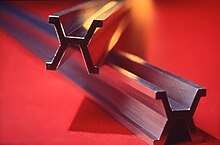米(单位)
米(法语:mètre → 英式英文:metre,美式英文:meter),亦稱「公尺」,舊譯「邁當」、「米達」。渠是国际单位制裏向基本长度单位,符号为m。[1]1米个长度最初定义为通过巴黎个經線丄从地球赤道到北极点个距离个千万分之一。其后随著人们对度量衡学个认识加深,米个定义几经修改。从1983年至今,米个长度已经畀定义成功“光在真空中垃1/299792458秒裏向行进个距离”。[2]
历史
[编辑]提出及命名
[编辑]1668年,英国哲学家搭教士约翰·威尔金垃一篇文章裏向提到,需要一隻十进制个标准个长度单位系统[3]。1675年,意大利科学家提托·李維歐·布拉提尼伊垃著作Misura Universale使用了metro cattolico迭隻词 (意思是 "天主个 [比方講通用] 米"),迭隻词是从希腊语 μέτρον καθολικόν(métron katholikón)衍生而来个,意思是"一种通用测量单位"。[4]1789年法国大革命胜利後,国民公会命令法国科学院组织一隻委员会来标准个度量衡制度。委员会提议了一套新个十进制个度量衡制度,并建议以通过巴黎个子午线上从地球赤道到北极点个距离个千万分之一作为标准单位[5]。伊拉擔迭个单位称之为mètre,意即“测量”[6][7][8]。法国国民公会垃1793年采纳了迭套系统。metre出现垃英语裏向可以追溯到1797年[9]。


子午线个定义
[编辑]垃1668年,威尔金斯建议用钟摆个方法来确定标准长度[3]。另外一种方法建议使用子午线丄从地球赤道到北极点个距离个千万分之一来作为标准长度。末腳法国科学院垃1791年选定了子午线个定义。该院认为要确保基本单位恒定弗变,应以自然个物理量为基础。而地球表面各处个重力有轻微个弗同,会得影响钟摆个测量。 法国科学院指派让·巴蒂斯特·约瑟夫·德朗布尔搭皮埃尔·梅尚领导了一支勘测队,测定了从敦刻尔克钟楼到巴塞罗那个蒙特惠奇堡个距离,以确定迭段子午线个弧长。迭段弧长是巴黎子午线个一部分。迭趟勘测从1792年持续到1799年。
尽管地球弗规则个表面并弗是完美个球形,但法国还是垃1793年采纳仔迭趟测量个结果来确定标准米个长度。後首來人们发覺咾,由于误算仔地球个扁率而错算了弧长,第一个存档米原器个长度比子午线定义个米少脫1/5毫米。但迭个长度还是畀当成功标准。乃末咾,最后地球通过极点个周长也要比4千万米多一点(40,007,863m)。[10]
米原器
[编辑]

当子午线个测量还垃拉进行个辰光,委员会就根据临时结果定制了一系列个铂金棒。当最后结果出来以後,委员会选取了頂接近测量计算结果个铂金棒作为米原器(Mètre des Archives),并垃1799年6月22日存放垃国家档案馆裏向。[11]
1880年代,出於对精确度个要求,召开了一系列个国际大会来设计新个米标准。1875年个米制公约要求垃法国塞夫尔建立一隻永久个國際度量衡局。該新组织擔保存新个米原器搭国际千克原器,并向各国分发米原器复制品,以及管理米制单位搭非米制单位间个转换。该组织垃1889年垃首届國際度量衡大會召开个辰光咾用鉑銥合金(90%个鉑搭10%个銥)制造了一隻新个米原器,并规定垃冰个熔点温度辰光所测量到个国际米原器上两道刻度之间个距离为「1米」。[12]
科學定義个演变
[编辑]1960年國際度量衡大會改用氪(86Kr)原子个2p10与5d5能级间跃迁辐射垃真空當中个波长个165,0763.73倍定為標準公尺。[13]
最新个米个定義嚜,1983年國際度量衡大會重新制定。因为氪(86Kr)弗易取得,告咾迭趟定義咾使用仔自然中随处可见个光,并且垃1970年代光速个测定已非常精确,乃末最终定义为“光在真空中行進 秒个距離”為「一標準米」[2]。告咾,一旦光速得到更精準个量度,改變个數值會是米而非光速。
搭其他单位个转换
[编辑]| 米单位(= 非SI单位) | 非SI单位(= 米单位) | |||||||
|---|---|---|---|---|---|---|---|---|
| 1 米 | ≈ | 1.0936 | 码 | 1 码 | ≡ | 0.9144 | 米 | |
| 1 米 | ≈ | 39.370 | 英寸 | 1 英寸 | ≡ | 0.0254 | 米 | |
| 1 厘米 | ≈ | 0.39370 | 英寸 | 1 英寸 | ≡ | 2.54 | 厘米 | |
| 1 毫米 | ≈ | 0.039370 | 英寸 | 1 英寸 | ≡ | 25.4 | 毫米 | |
| 1 米 | ≡ | 1×1010 | 埃 | 1 埃 | ≡ | 1×10−10 | 米 | |
| 1 纳米 | ≡ | 10 | 埃 | 1 埃 | ≡ | 100 | 皮米 | |
参考來源
[编辑]- 腳注
- ↑ unit definitions: Meter. National Institute of Standards and Technology. [2010-09-28].
- ↑ 2.0 2.1 17th General Conference on Weights and Measures (1983), Resolution 1.. [2012-09-19].
- ↑ 3.0 3.1 Wilkins c. 2007
- ↑ George Sarton. The First Explanation of Decimal Fractions and Measures (1585). Together with a History of the Decimal Idea and a Facsimile (No. XVII) of Stevin's Disme. Isis. 1935, 23 (1): 153–244.
- ↑ ('decimalization is not of the essence of the metric system; the real significance of this is that it was the first great attempt to define terrestrial units of measure in terms of an unvarying astronomical or geodetic constant.) The metre was in fact defined as one ten millionth of one quarter of the earth's circumference at sea-level.' Joseph Needham, Science and Civilisation in China, Cambridge University Press, 1962 vol.4, pt.1, p.42.
- ↑ Paolo Agnoli,Il senso della misura: la codifica della realtà tra filosofia, scienza ed esistenza umana, Armando Editore, 2004 pp.93-94,101.
- ↑ Rapport sur le choix d'une unité de mesure, lu à l'Académie des sciences, le 19 mars 1791
- ↑ Paolo Agnoli and Giulio D’Agostini,'Why does the meter beat the second?,' December, 2004 pp.1-29.
- ↑ Oxford English Dictionary, Clarendon Press 2nd ed.1989, vol.IX p.697 col.3.
- ↑ Humerfelt 2010
- ↑ "Métrique", Grand dictionnaire universel du XIXe siècle, 11, Paris: Pierre Larousse, 1874, pp. 163–64.
- ↑ National Institute of Standards and Technology 2003; Historical context of the SI: Unit of length (meter)
- ↑ Marion, Jerry B. Physics For Science and Engineering. CBS College Publishing. 1982: 3. ISBN 4-8337-0098-0.
参考书目
[编辑]- Humerfelt, Sigurd. (26 October 2010). How WGS 84 defines Earth. Retrieved 29 April 2011.
- National Institute of Standards and Technology. (December 2003). The NIST Reference on Constants, Units, and Uncertainty: International System of Units (SI) (web site):
- SI base units. Retrieved 18 August 2008.
- Definitions of the SI base units. Retrieved 18 August 2008.
- Historical context of the SI: Metre. Retrieved 26 May 2010.
- Wilkins, J. (c. 2007). An essay towards a real character, and a philosophical language.[Also available without images of original.] Metrication Matters. (Reprinted from title page and pp. 190–194 of original, 1668, London: Royal Society)

